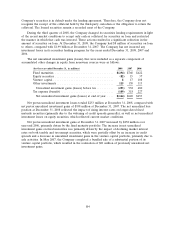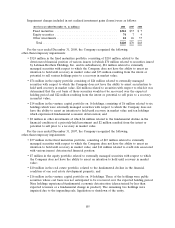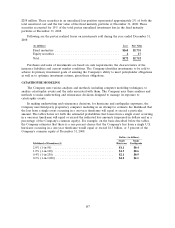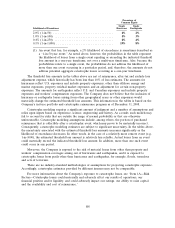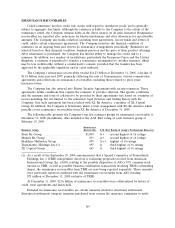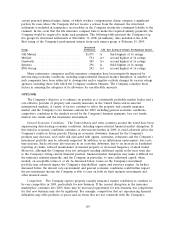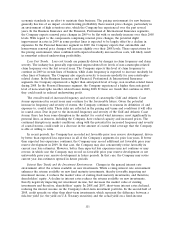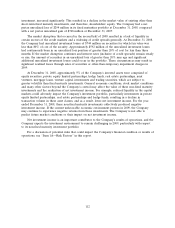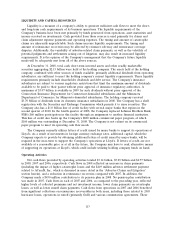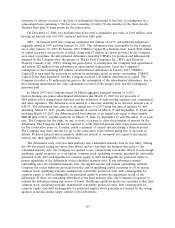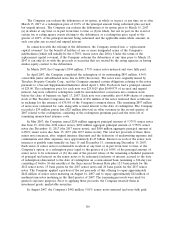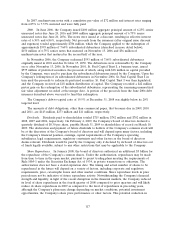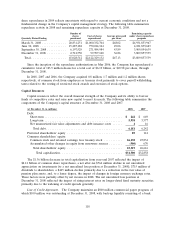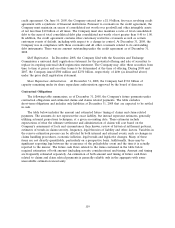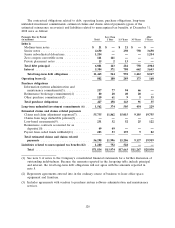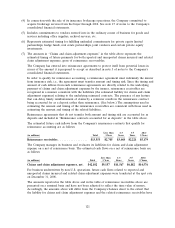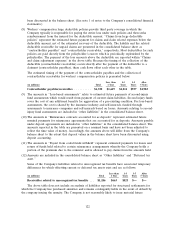Travelers 2008 Annual Report Download - page 125
Download and view the complete annual report
Please find page 125 of the 2008 Travelers annual report below. You can navigate through the pages in the report by either clicking on the pages listed below, or by using the keyword search tool below to find specific information within the annual report.LIQUIDITY AND CAPITAL RESOURCES
Liquidity is a measure of a company’s ability to generate sufficient cash flows to meet the short-
and long-term cash requirements of its business operations. The liquidity requirements of the
Company’s business have been met primarily by funds generated from operations, asset maturities and
income received on investments. Cash provided from these sources is used primarily for claims and
claim adjustment expense payments and operating expenses. The timing and amount of catastrophe
claims are inherently unpredictable. Such claims increase liquidity requirements. The timing and
amount of reinsurance recoveries may be affected by reinsurer solvency and reinsurance coverage
disputes. Additionally, the variability of asbestos-related claim payments, as well as the volatility of
potential judgments and settlements arising out of litigation, may also result in increased liquidity
requirements. It is the opinion of the Company’s management that the Company’s future liquidity
needs will be adequately met from all of the above sources.
At December 31, 2008, total cash, short-term invested assets and other readily marketable
securities aggregating $2.15 billion were held at the holding company. The assets held at the holding
company, combined with other sources of funds available, primarily additional dividends from operating
subsidiaries, are sufficient to meet the holding company’s current liquidity requirements. These liquidity
requirements primarily include shareholder dividends and debt service. The Company’s insurance
subsidiaries are subject to various regulatory restrictions that limit the maximum amount of dividends
available to be paid to their parent without prior approval of insurance regulatory authorities. A
maximum of $3.07 billion is available in 2009 for such dividends without prior approval of the
Connecticut Insurance Department for Connecticut-domiciled subsidiaries and the Minnesota
Department of Commerce for Minnesota-domiciled subsidiaries. The holding company received
$3.70 billion of dividends from its domestic insurance subsidiaries in 2008. The Company has a shelf
registration with the Securities and Exchange Commission which permits it to issue securities. The
Company also has a $1.0 billion line of credit facility with several major banks that expires in the
second quarter of 2010. In the fourth quarter of 2008, the Company replaced Lehman Brothers Bank,
FSB’s $60 million participation in this facility through an assignment to another financial institution.
This line of credit also backs up the Company’s $800 million commercial paper program, of which
$100 million was outstanding at December 31, 2008. The Company is not reliant on its commercial
paper program to meet its operating cash flow needs.
The Company currently utilizes letters of credit issued by major banks to support its operations at
Lloyd’s. As a result of movements in foreign currency exchange rates, additional capital, which the
Company expects to provide by obtaining additional letters of credit issued by major banks, will be
required in the near-term to support the Company’s operations at Lloyd’s. If letters of credit are not
available at a reasonable price or at all in the future, the Company may have to seek alternative means
of supporting its operations at Lloyd’s, which could include utilizing holding company funds on hand.
Operating Activities
Net cash flows provided by operating activities totaled $3.14 billion, $5.29 billion and $4.77 billion
in 2008, 2007 and 2006, respectively. Cash flows in 2008 reflected an increase in claim payments
(including the impact of higher catastrophe losses and the $449 million asbestos settlement payment
related to ACandS, Inc., which is discussed in more detail in the ‘‘Asbestos Claims and Litigation’’
section herein), and a reduction in reinsurance recoveries compared with 2007. In addition, the
Company made a $450 million contribution to its pension plan in 2008. No pension plan contribution
was made in 2007. Cash flows in each of 2007 and 2006, as compared to the preceding year, reflected
higher levels of collected premiums and net investment income, lower claim payments on catastrophe
losses, as well as lower runoff claim payments. Cash flows from operations in 2007 and 2006 benefited
from significant collections on reinsurance recoverables in both years, including those related to 2005
hurricane losses, operations in runoff (primarily Gulf) and various commutation agreements. These
113



